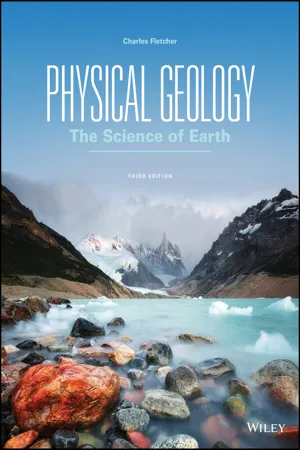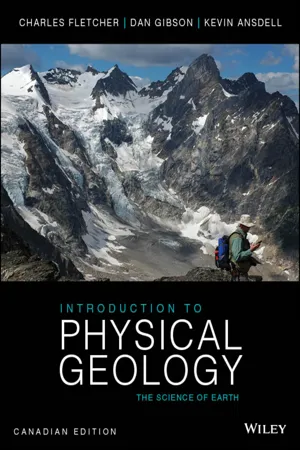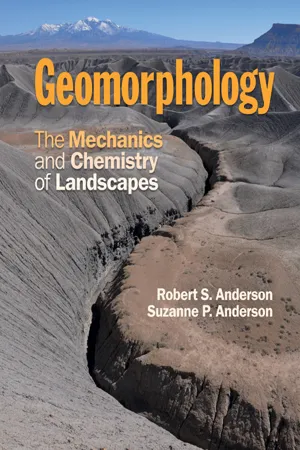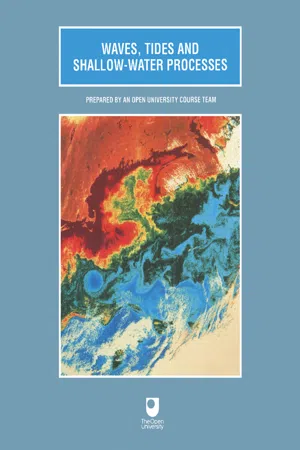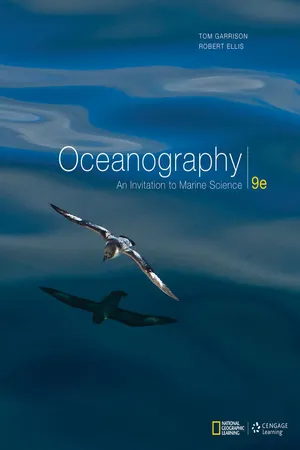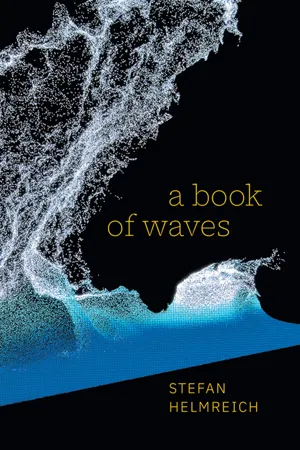Geography
Waves
Waves in geography refer to the movement of energy through a medium, typically the ocean. They are caused by the wind, tides, and other natural forces, and play a significant role in shaping coastlines and influencing coastal ecosystems. Waves can be classified based on their size, speed, and the forces that generate them, and are essential to understanding coastal geography and erosion.
Written by Perlego with AI-assistance
Related key terms
1 of 5
9 Key excerpts on "Waves"
- eBook - PDF
Physical Geology
The Science of Earth
- Charles Fletcher(Author)
- 2017(Publication Date)
- Wiley(Publisher)
The landward extent of the foreshore is marked by a berm, a ridge of sand built by Waves at high tide that deliver sand to the top of the foreshore. Landward of the berm is the backshore, which is characterized by a coastal dune, an accumulation of wind-blown sand into a low hill vegetated with salt-tolerant plants. 20.2 Wave Energy Is the Dominant Force Driving Natural Coastal Change Wind Waves Perhaps you have watched a breeze move across a quiet body of water, gently disturbing the surface and forming LO 20.2 Describe the transformation of Waves as they travel from deeper to shallower water. Waves on the ocean surface are generated by the fric- tion of air blowing across the water—the reason they are called wind Waves. small ripples. As it does so, it is transferring energy from the atmosphere into the water by displacing individual molecules of water. The molecules move in a circle, called an orbital, that is largest at the surface and gets smaller with depth (Figure 20.4). A moving wave looks as if it is transporting water, but it is not. Just as music travels through the air without making wind, a wave travels across the ocean surface without making a current. (In the surf zone, however, Waves do make currents.) Rather, energy (Waves) radiates outward from the point at which the wind interacts with the ocean surface, but water does not. The size of a wave is governed by wind velocity, fetch (the distance over which the wind blows), and duration of time that the wind disturbs the water. Waves are described by their height, the vertical distance between the peak of a crest and the bottom of a trough; their wavelength (L), the horizontal distance between two succes- sive Waves; and their period, the time it takes for two succes- sive wave crests to pass a given point in space. In general, the circular water motion generated by a wave extends to a depth equal to half the wavelength (L/2). - eBook - PDF
- Charles Fletcher, Dan Gibson, Kevin Ansdell(Authors)
- 2014(Publication Date)
- Wiley(Publisher)
The molecules move in a circle called an orbital that is largest at the surface and gets smaller with depth (FIGURE 22.4). A moving wave looks as if it is transporting water, but it is not. Just as music travels through the air without making wind, a wave travels across the ocean surface without making a current. (In the surf zone, however, Waves do make currents.) Energy (Waves) radi- ates outward from the point at which the wind interacts with the ocean surface, but water does not. The size of a wave is governed by 2UELWDO PRWLRQ 2UELWDOV GHIRUPHG E\ IULFWLRQ DW VHD IORRU 7XUEXOHQW ZDWHU :DYH ILUVW ´IHHOV ERWWRPµ KHUH :DYH EDVH 'HHS ZDWHU 6KDOORZ ZDWHU %HDFK 6ZDVK 6XUI + %UHDNLQJ ZDYH :DYH EHFRPHV KLJKHU DQG VWHHSHU 6HGLPHQW PRWLRQ :DYHOHQJWK λ 2UELWDO GHFUHDVHV ZLWK GHSWK 1HJOLJLEOH PRWLRQ DW GHSWK HTXDO WR λ :DYH EDVH :DYH GLUHFWLRQ wind velocity, fetch (the distance over which the wind blows), and the duration of time that the wind disturbs the water. Waves are described by their height, the vertical distance between the peak of a crest and the bottom of a trough; their wavelength (λ), the horizontal distance between two successive Waves; and their pe- riod, the time it takes for two successive wave crests to pass a given point in space. In general, the circular water motion generated by a wave extends to a depth equal to half the wave length (λ/2). The ocean’s surface in a wave-generating area, called a sea, is cha- otic and disturbed due to high wind velocities. A sea consists of steep, sharp-crested Waves of many different heights, lengths, and periods. As Waves move out of the area of generation in the absence of lo- cal wind, they become swells, which are long, regular, symmetrical Waves with periods ranging from 5 to 20 s. Swells are noticeable as the smooth rolling action of the ocean surface. Each swell transfers energy horizontally across the ocean’s surface (FIGURE 22.5). - eBook - PDF
- John Edward Huth(Author)
- 2013(Publication Date)
- Belknap Press(Publisher)
12. Reading the Waves on the ocean , Waves are usually a by-product of the weather: wind over water. It could be a gentle breeze creating a cat’s paw pattern on a pond or giant swells kicked up by a typhoon. To most the ocean surface may seem random and inscrutable, yet there is almost a boundless amount of information hidden in plain view, if only the meaning can be deciphered. The existence of distant storms is betrayed by ocean swells racing over thousands of miles with undiminished power. The presence of an island thirty miles away will reveal itself through the pattern of reflected Waves. Experienced navigators can deduce meaning in wave patterns. Waves are disturbances that travel through a medium, such as air or water, and come in many forms. Sound and water Waves are two familiar examples. The medium itself doesn’t move, but the disturbance travels. Waves are described in science textbooks by a wavelength, and amplitude, as in Figure 138. These are often called sine Waves after the name of the mathematical function . The wavelength is the distance between one crest and the next. Displacement Position Amplitude Height Wavelength Direction of motion Figure 138 Typical sine wave, showing its amplitude, height, and wavelength. 292 The Lost Art of Finding Our Way The amplitude describes the size or height of the disturbance as measured from the middle to the top of the crest. A water wave is a disturbance at the boundary between water and air. Water Waves can be much steeper than the textbook sine wave in Figure 138. If you ask a child to draw Waves in the ocean, you would probably get something with sharp peaks, as in Figure 139. Mathematicians call this shape a trochoid — a curve traced out by a point on the rim of a wheel as it rolls along the ground. For trochoidal Waves the textbook amplitude isn’t easily defined. For these peaked Waves the distance from the trough to the crest is easier to measure and is called the wave height. - eBook - PDF
- Tom Garrison, Robert Ellis(Authors)
- 2017(Publication Date)
- Cengage Learning EMEA(Publisher)
Copyright 2018 Cengage Learning. All Rights Reserved. May not be copied, scanned, or duplicated, in whole or in part. WCN 02-300 125 7 Waves and Tides KEY CONCEPTS Waves transmit energy, not water mass, across the ocean’s surface. Water particles within a wave move in orbital patterns. Where the ocean is deeper than half the wavelength, Waves are unaffected by the seafloor. The wavelength of tsunami and tides are so great that they are always in shallow water. Tides are periodic short-term changes in ocean surface height. Different tidal patterns and heights occur in different areas of Earth. The equilibrium theory of tides explains tides by exam-ining the gravitational and inertial interactions among the Earth, moon, and sun. The dynamic theory of tides takes into account seabed contour, water’s viscosity, and tide wave inertia. The immense power associated with a breaking wave is clearly visible from within the tube. Willyam Bradberry/Shutterstock.com Copyright 2018 Cengage Learning. All Rights Reserved. May not be copied, scanned, or duplicated, in whole or in part. WCN 02-300 CHAPTER 7 126 7.1 Ocean Waves Move Energy across the Sea Surface To most people an ocean wave in deep water appears to be a massive moving object—a ridge of water traveling across the sea surface. An ocean wave is one of several kinds of Waves , all of which are disturbances caused by the movement of energy from a source through some medium (solid, liquid, or gas). As the energy of the disturbance travels, the medium through which it passes (water) moves in specific ways. Sometimes this movement is visible to us as crests or ridges. The traveling crests produce the appearance of movement we see in a wave. In an ocean wave, a ribbon of energy is moving forward at the speed of the wave, but water is not. In a sense, the wave is an illusion. Picture a resting seagull as it bobs on the wavy ocean sur-face far from shore. - eBook - PDF
Geomorphology
The Mechanics and Chemistry of Landscapes
- Robert S. Anderson, Suzanne P. Anderson(Authors)
- 2010(Publication Date)
- Cambridge University Press(Publisher)
C H A P T E R 1 6 Coastal geomorphology In every outthrust headland, in every curving beach, in every grain of sand there is the story of the earth. Rachel Carson 502 Coasts are the most dynamic elements of the world’s landscapes. This reflects the arrival of energy in the form of Waves that are generated by winds beneath storms at sea. Millions of Waves arrive each year to every site along the ocean perimeter. Most of the energy from these Waves is dissipated in the coastal zone, some of it converted to work of both sediment transport and erosion of rock. The coasts serve as the bottom or exterior boundary condition for the terrestrial landscape. The evolving coastline influences both the gradients of the rivers and the heights of the cliffs in rocky coastlines. The oceans are the final sinks for sediment and water from the terrestrial landscape. In this chapter Delta of the Orinoco River, Venezuela. Contours colored using cyclic bands at 1 m contour intervals, from SRTM 90 m DEM. Landscape above 100 m is black (image courtesy of James Syvitski, INSTAAR, University of Colorado). 503 As Waves are all-important in the coastal zone, we will address both their origin in the deeper ocean, and their transformation as they approach shore. Winds at sea generate a broad spectrum of Waves. At any particular coastal site, we can characterize the arriv-ing spectrum of Waves, called the wave climate. We will characterize the concentration of energy in a wave, and the rate at which that energy is delivered to the coast as it moves. It is the large Waves that accomplish much of the work. Sediment delivered to the coast by rivers generates deltas that are some of the most productive agricul-tural sites in the world and house tens of millions of people, but are also, for the same reasons, vulnerable to large-scale disasters both from floods from upstream and from the ocean. - eBook - PDF
Waves, Tides and Shallow-Water Processes
Waves, Tides and Shallow-Water Processes
- Open Open University, Joan Brown, Gerry Bearman(Authors)
- 2013(Publication Date)
- Butterworth-Heinemann(Publisher)
(A ripple shows very little change in shape as it travels across a pond.) 4 The disturbance appears to be propagated with constant speed. A wave transfers a disturbance from one part of a material to another. If the material itself is not being transported by wave propagation, then what is being transported? The answer, ‘energy’, provides a reasonable working definition of wave motion-a process whereby energy is transported across or through a material without any significant overall transport of the material itself. So, if energy, and not material, is being transported, what is the nature of the movement observed when ripples cross a pond? There are two aspects to be considered: first, the progress of the Waves (which we have already noted), and secondly, the movement of the water particles themselves. Superficial observation of the effect of ripples on a floating cork suggests that the water particles move ‘up and down’, but closer observation will reveal that, provided the water is very much deeper than the ripple height, the cork is describing a nearly circular path in a vertical plane, parallel with the direction of wave movement. In a more general sense, the particles are displaced from an equilibrium position, and then return to that position. Thus, the particles experience a displacing force and a restoring force. The nature of these forces is often used in the descriptions of various types of Waves. 1.1.1 TYPES OF Waves All Waves can be regarded as progressive Waves, in that energy is moving through, or across the surface of, the material. The so-called standing wave, of which the plucked guitar string is an example, can be considered as the sum of two progressive Waves of equal 9 dimensions, but travelling in opposite directions. We examine this in more detail in Section 1.5.4. Waves which travel through the material are called body Waves. - eBook - PDF
Oceanography
An Invitation to Marine Science
- Tom Garrison(Author)
- 2015(Publication Date)
- Cengage Learning EMEA(Publisher)
The be-havior of Waves depends largely on the relation between a wave’s size and the depth of water through which it is moving. Waves can refract and reflect, break, and interfere with one another. Wind Waves can be deep-water Waves if the water is more than half their wavelength deep. The Waves of very long wavelengths are always in “shallow water” (water less than half their wavelength deep). These long Waves travel at high speeds, and some may have great destructive power. In the next chapter you will learn that even greater Waves ex-ist: the tides. You may be interested to know that two “tidal Waves” move along most coasts each day. You don’t read of daily mayhem and destruction from these passages because the crests are the day’s high tides; and the troughs, the day’s low tides. Tides are shallow-water Waves no matter how deep the ocean they’re moving through. Tides can be destructive, but among all Waves their ability to cause damage is fortunately not proportional to their wavelengths. QUESTIONS FROM STUDENTS 1. If so much energy is expended as wind Waves break, why doesn’t water in the surf zone get hot? The amount of energy moving through the ocean in progressive Waves is impressive. The energy of a wave is proportional to the square of its height. Each linear meter of a wave 2 meters (6.5 feet) above average sea level represents an energy flow of about 25 kilo-watts (34 horsepower), enough to light 250 light bulbs (100 watts each); a wave twice as high contains four times as much energy. A single wave 1.2 meters high striking the west coast of the United States may release as much as 50 million horsepower! The energy of wind Waves is dissipated mostly as heat in the surf, but since water has such a high latent heat (discussed in Chapter 6), the injection of heat into the surf zone doesn’t significantly increase water temperature. The surf zone is also an area of vigorous mixing, so any heat released is quickly dis-tributed through a large volume of water. - eBook - PDF
- Stefan Helmreich(Author)
- 2023(Publication Date)
- Duke University Press Books(Publisher)
The range of practices bundled under this ecumenical definition of reading—taking readings, enumerating, calculating, watching, even, sometimes, machine-aided hydrophonic listening—underscores an additional claim I make, which is that Waves emerge in these reading rela- tions as media, or material forms that convey meaning (oceanic, climatic, anthropogenic) to wave researchers and their publics. This may not be a surprise, since the ocean, especially its farther reaches, for humans often requires access through the mediation of technology. Media technologies (e.g., radio, photography, buoys) have enabled and guided how scientists understand ocean Waves. More, Waves have, in the process, become understood and experienced as media themselves. 38 The literary theorists John Durham Peters (2015) and Melody Jue (2020) approach the elemental properties of water, atmosphere, and weather as media, both in the environmental sense (think of seawater as that medium in which dolphins swim, methane hydrate bubbles, and Waves uncoil) and in the sense of communication infrastructure (think of sonar as that medium that channels information through the propagation of echoing underwater acoustic signals). 39 Waves as media carry signals about where they come from, what they are made of, and where they are going. In the early twentieth century, the Swiss linguist Ferdinand de Saussure used a wave analogy to describe how humans make meaning through language. He illustrated the relation between thinking and speaking with a diagram to be read from left to right as a wavy flow of time (figure I.7). For Saussure, (A) “the indefinite plane of jumbled ideas” and (B) “the equally vague plane of sounds” mutually inform one another, creating units—divided, in the diagram, by dotted lines—which he called signs, composed of signifieds (ideas) and signifiers (sounds, or, more broadly, articulations). - eBook - PDF
- P.H. LeBlond, L.A. Mysak(Authors)
- 1981(Publication Date)
- Elsevier Science(Publisher)
For example, Guza and Davis (1974) showed that a standing gravity wave normally incident on a sloping beach can transfei energy to edge Waves through a weah iesonant interaction resulting from the instability of the incident wive with respect tc I xturbation by edge Waves. Their results suagest that subharmonic, 'owestmode edge Waves are p,eferentially excited. Cuza and Bowcn (1975) exteiided this theory to the case of arbitrary incidence. Fuller and Mysak (1977), on the other hand, showed that when a pru zi~y wdve i. incident upon a single-step whose coastline has an ir- regular shape, onc or more edge Waves can be generated on the shelf through a resonant interaction of the ir,cident wave with the wavenumber spectrum of the coastal irregularities 55 1 Continental shelf Waves As an introduction to the study of shelf wave generation, let us recall some of their salient properties. A shelf wave is a type of topographic planetary wave and hence is highly rotational: its motion consists of a sequence of horizontal eddies of alternating sign propagating along and confined to the shelf/slope region (see Fig. 24.5 for an experi- mental reproduction of such eddy motions). In the Northern Hemisphere, the coast lies to the right of the direction of phase propagation. It is now generally accepted that these Waves are generated by the large-scale weather systems that move across or along the shelf. They have periods of about one week, wavelengths of order 103km and pressure and wind-stress fluctuations of order 5 mbar and 1 dyne/cm2 , respectively. Consequently, in the ocean, shelf Waves have long wavelengths (L S 1, where 1 is the width of the shelf/slope region), low frequencies (w Sf) and small amplitudes (a few centimeters).
Index pages curate the most relevant extracts from our library of academic textbooks. They’ve been created using an in-house natural language model (NLM), each adding context and meaning to key research topics.
